Every day is a new opportunity for our youngest learners to ask “Why?” over and over. Tap into that curiosity with these fun and engaging science activities for preschoolers. These simple experiments incorporate many preschool favorites like playing with bubbles or water, making arts and crafts, and, of course, making a mess!
To make things even easier, we’ve rated every one of these science activities for preschoolers based on difficulty and materials.
Difficulty:
- Easy: These are low- or no-prep experiments you can do pretty much anytime
- Medium: These take a little more setup or a longer time to complete
- Advanced: Experiments like these take a fairly big commitment of time or effort
Materials:
- Basic: Simple items you probably already have around the house
- Medium: Items that you might not already have but are easy to get your hands on
- Advanced: These require specialized or more expensive supplies to complete
Jump to:
Plus, click the button below to receive a copy of our free printable Science Experiment Recording Sheet.

Water Preschool Science Experiments
These water activities for preschoolers help teach little learners a variety of science concepts. (These can get a little messy, so you might want to try them outside.) Find even more water science activities here.
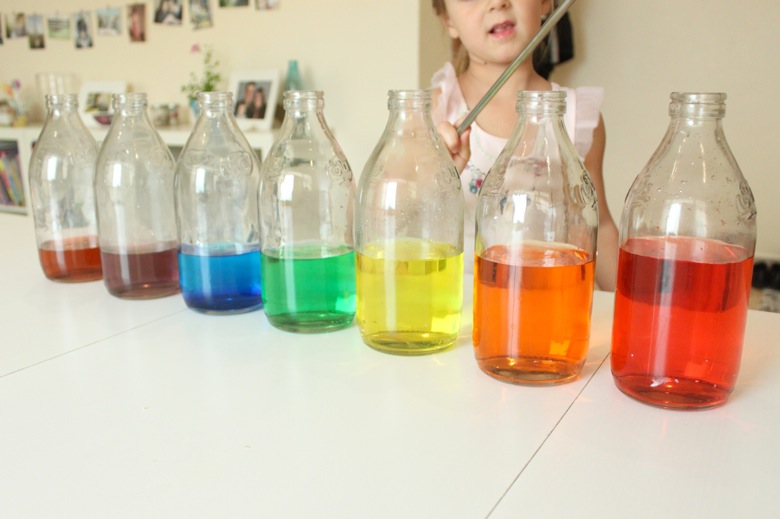
1. Make music with xylophone bottles
Difficulty: Easy / Materials: Basic
The classic experiment using varying levels of water in glasses or bottles is even more fun when you add some food coloring. Experiment with different water depths and mallet styles to make all kinds of beautiful music.
Learn more: Xylophone Bottle
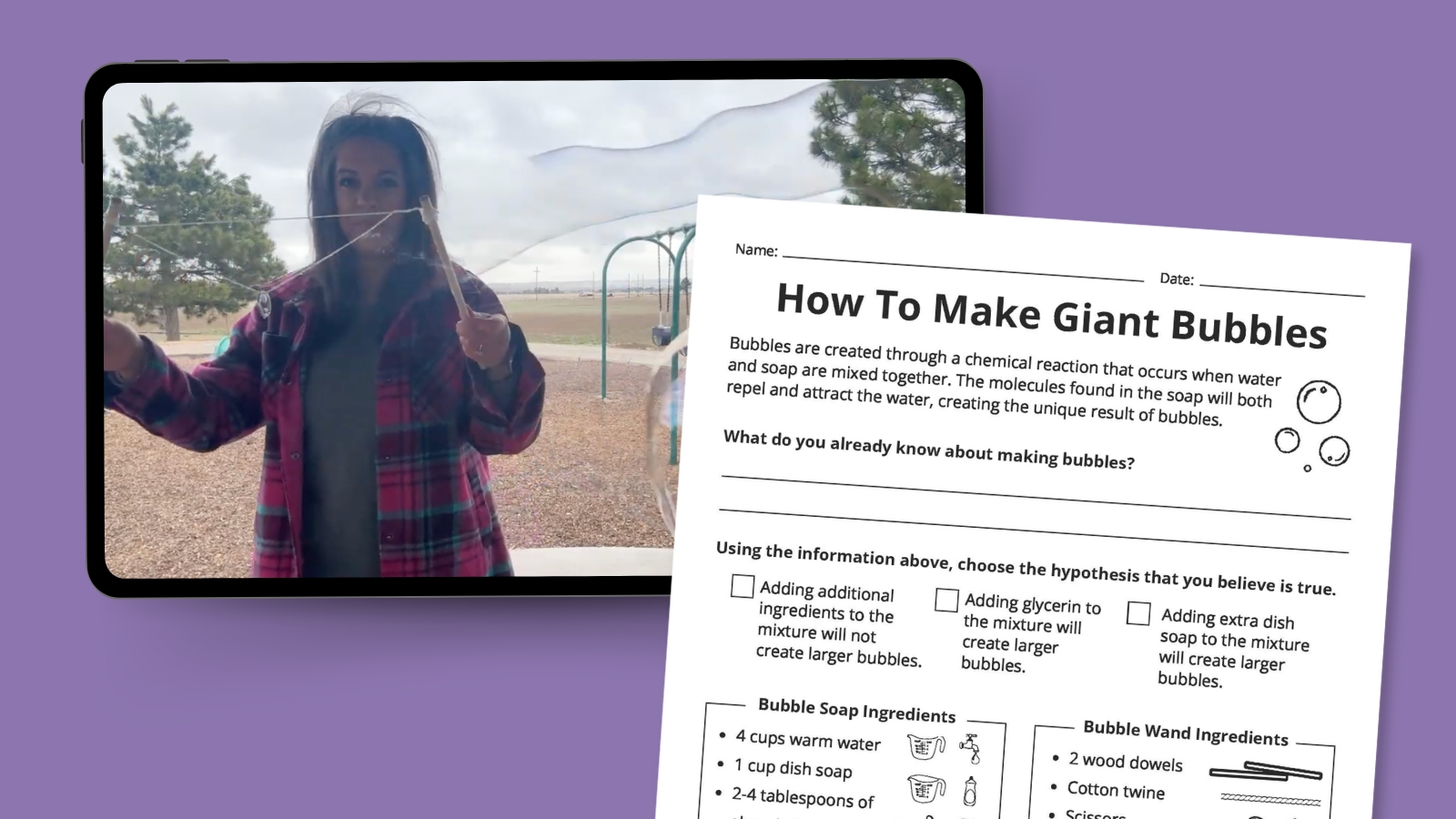
2. Make giant bubbles
Difficulty: Easy / Materials: Medium
Kids (and let’s face it, adults too) will definitely get a kick out of this fun science experiment. Learn how to make the bubble solution as well as the giant wand in our free video at the link below.
Learn more: Giant Bubbles

3. Watch rice dance in water
Difficulty: Easy / Materials: Basic
There are lots of cool baking-soda-and-vinegar experiments out there (ever made your own volcano?), but this one is always a favorite with little ones. The acid-base reaction causes the rice to dance and jump around in the water for an effect that is just so cool!
Learn more: Dancing Rice

4. Reveal colors with chemical reactions
Difficulty: Easy / Materials: Basic
Preschool science experiments often include a combination of baking soda and vinegar like this one. Fill muffin tins with a drop of food coloring, then top it with baking soda. Finally, let kids squirt in vinegar to reveal fabulous foamy hues. (Be sure to wear eye protection for this one.)
Learn more: Fizzy Fun

5. See what sinks and what floats
Difficulty: Easy / Materials: Basic
This preschool science activity helps kids learn to construct a hypothesis, conduct a simple experiment, and then sort their findings by property.
Learn more: Sink or Float Experiment

6. Learn what dissolves in water
Difficulty: Easy / Materials: Basic
Engage in more water play by having kids predict which items will dissolve in water and which ones won’t. Have kids keep track of the results so they can see if they have anything in common.
Learn more: What Dissolves in Water?
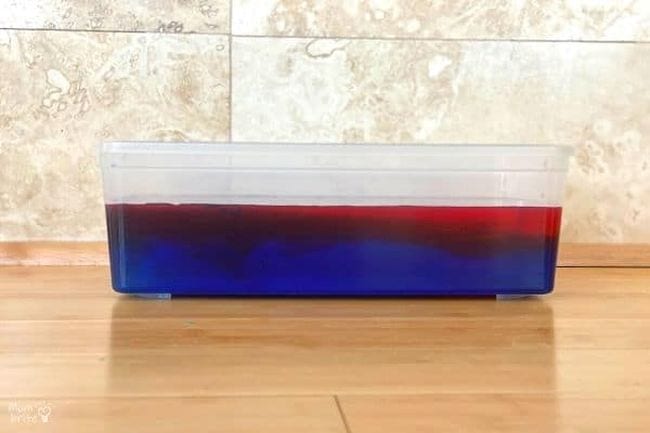
7. Watch hot water rise and cold water sink
Difficulty: Easy / Materials: Basic
This early exploration into the concept of density is always impressive to see in action. Have kids discover how hot water rises and cold water sinks. Explain that the same applies to air, and see if kids can think of a way to observe that in action too.
Learn more: Water Density Experiment
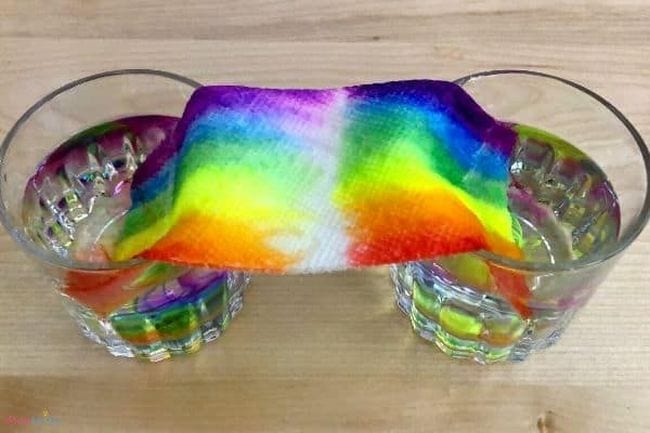
8. Grow a paper towel rainbow
Difficulty: Easy / Materials: Basic
“Capillary action” might be a real mouthful for preschool science students, but they don’t need to remember the term to be impressed by this experiment. All you need are markers, a paper towel, and two glasses of water.
Learn more: Capillary Action Experiment

9. Make shaving cream rain clouds
Difficulty: Easy / Materials: Basic
One of our favorite science activities for preschoolers. This is a classic science activity every kid should try at least once. It helps them understand how clouds become so saturated with water that they must release it in the form of rain.
Learn more: Shaving Cream Rain Clouds
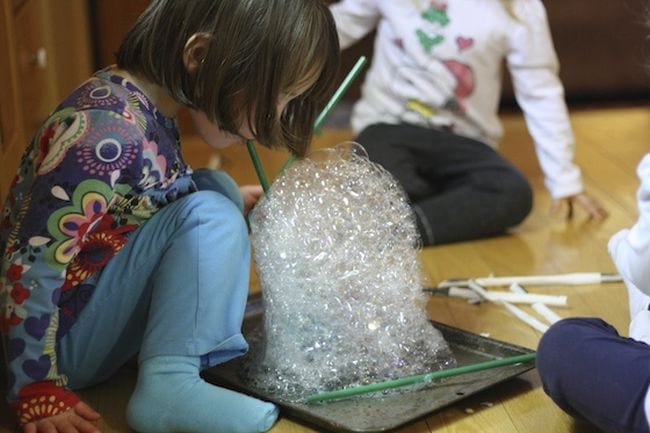
STEM Challenges for Preschoolers
STEM challenges give students a chance to try solving problems on their own. Give them some basic supplies and instructions, then let them experiment until they find a solution to the challenge.

11. Rescue toys from hot lava
Difficulty: Easy / Materials: Basic
While you might not want pre-K kids climbing all over the classroom furniture to play “The Floor Is Lava,” they can do the same thing with their toys in this cute STEM challenge.
Learn more: The Floor Is Lava

12. Build a catapult
Difficulty: Easy / Materials: Basic
Challenge students to build a catapult using just three items: Popsicle sticks, elastics, and a plastic spoon or bottle cap. You’ll definitely want to have an extra set of adult hands available as this can prove challenging for pre-K kids. Finally, bring plenty of marshmallows or pom-poms to launch.
Learn more: Popsicle Stick Catapult

13. Discover strength in shapes
Difficulty: Easy / Materials: Basic
Learn shapes while also practicing some basic science. Fold paper into various shapes to form columns and ask kids to predict which will be able to support the most books.
Learn more: Which Shape Is Strongest?
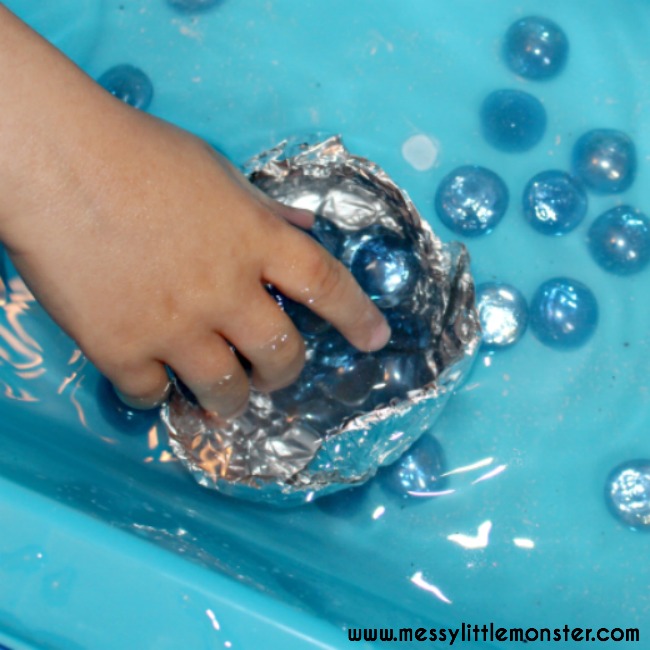
14. Build an aluminum foil boat
Difficulty: Easy / Materials: Basic
Teach kids about buoyancy and physics while having fun in the process. First, give your students some tinfoil and challenge them to build a sturdy boat. Then, challenge them to fill the boat with as many objects, such as gems, as they can without it sinking.
Learn more: Aluminum Foil Boat

15. Waterproof a boot
Difficulty: Easy / Materials: Basic
Ask kids to select various materials and tape them over the free boot printable found at the link. Then, test their hypotheses to see which ones work best.
Learn more: Waterproof a Boot
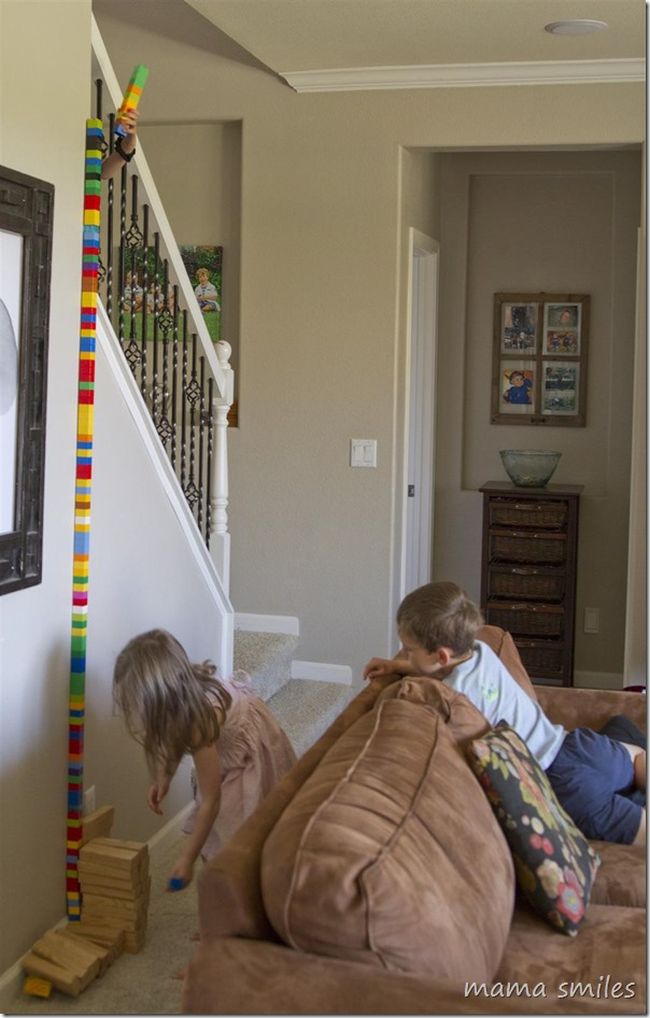
16. Reach for the sky
Difficulty: Easy / Materials: Basic
Round up all your building blocks and try this whole-class project. What will students need to do to be able to construct a tower that reaches all the way to the ceiling?
Learn more: Tower Engineering Challenge
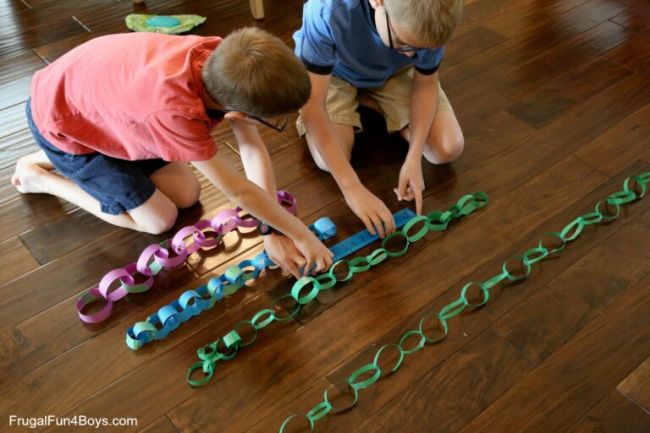
17. Link up the longest paper chain
Difficulty: Easy / Materials: Basic
This incredibly easy preschool STEM activity really gets kids thinking. The challenge? Create the longest possible paper chain using a single piece of paper. So simple and so effective.
Learn more: Paper Chain Challenge
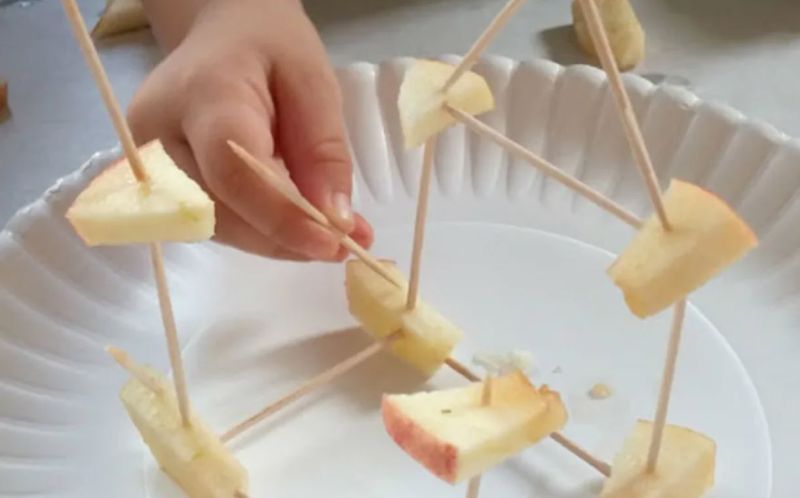
18. Build an apple-toothpick tower
Difficulty: Easy / Materials: Basic
Put a healthy spin on a classic STEM challenge by substituting apple pieces for marshmallows. Kids will have a tasty snack when they’re done!
Learn more: Apple Toothpick Tower

19. Stack up plastic cups
Difficulty: Easy / Materials: Basic
Kids absolutely love stacking cups! Turn the play into a STEM challenge by adding index cards into the mix. Kids can experiment to see if they can build taller towers with or without the cards.
Learn more: Solo Cup Engineering Challenge
20. Craft a nest
Difficulty: Easy / Materials: Basic
Take a nature walk and pick up items like sticks, leaves, and more. Then, build your own bird nests to protect little eggs and hatchlings.
Learn more: Build a Nest at Pink Stripey Socks
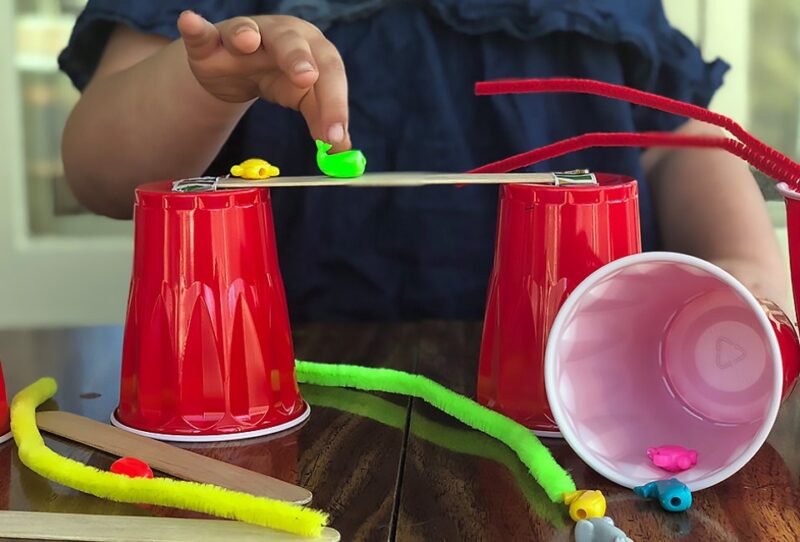
21. Be bridge-builders
Difficulty: Easy / Materials: Basic
Use everyday classroom objects to build bridges and test their strength. See how many objects (beads, toys, school supplies, etc.) each bridge can hold before it collapses.
Learn more: Build a Bridge
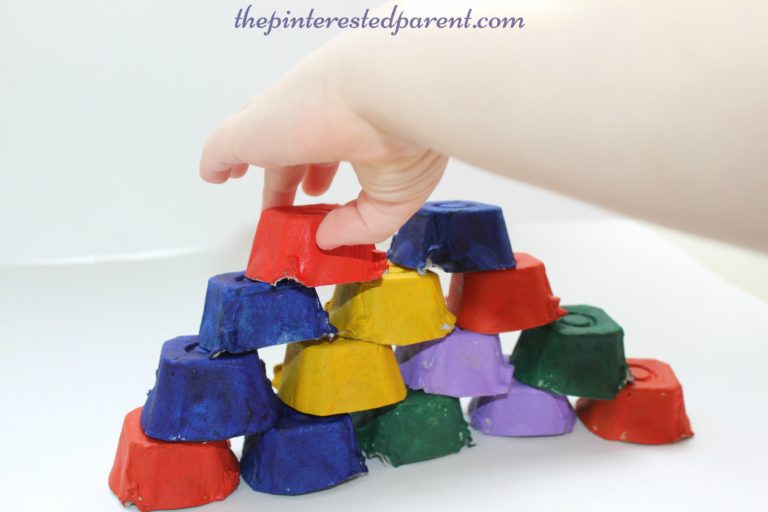
22. Construct with egg carton building blocks
Difficulty: Easy / Materials: Basic
These colorful building blocks are not only pleasantly tactile, they’re made from bio-degradable materials. A win-win!
Learn more: Egg Carton Building Blocks
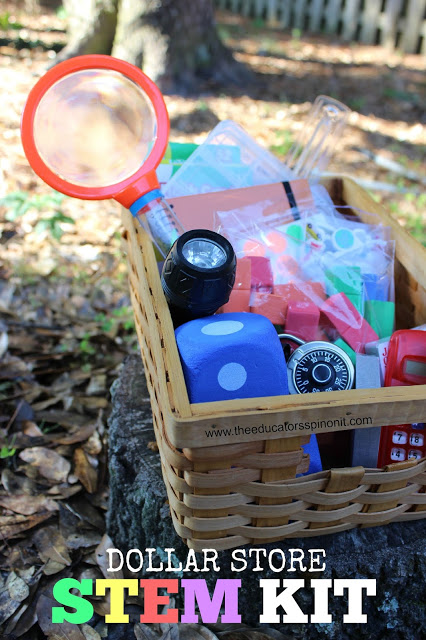
23. Put together a tinker kit
Difficulty: Easy / Materials: Basic
Young kids really don’t need fancy, expensive equipment to learn about and enjoy science. A basket full of everyday items, most available at the dollar store, and a big imagination are all it takes.
Learn more: Tinker Kit
Seasonal Science Activities and Experiments for Preschoolers
Whether you’re looking for Halloween science activities, winter science experiments, or Easter egg activities, find them all (and more) here!
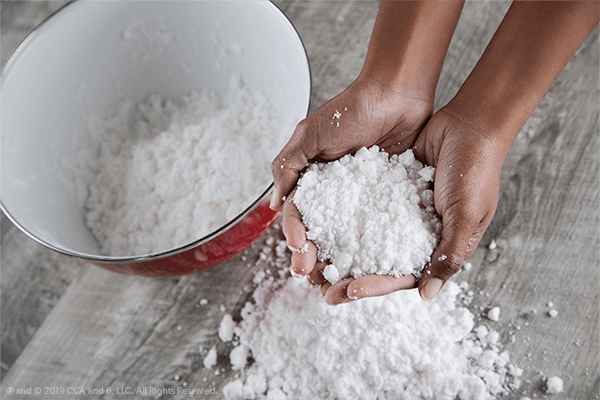
24. Make artificial snow
Difficulty: Easy / Materials: Basic
No snow where you live? Make some yourself! Find easy recipes for “snow” using baking soda, shaving cream, cornstarch, and other household items. Experiment to find the one that works best.
Learn more: Make Pretend Snow

25. Explore how mittens keep you warm
Difficulty: Easy / Materials: Basic
Ask little ones if mittens are warm, and they’ll likely answer yes. But when they measure the temperature inside an empty mitten, they’ll be surprised by what they find. Learn about body heat and insulation with this easy experiment.
Learn more: Mitten Body Heat Experiment
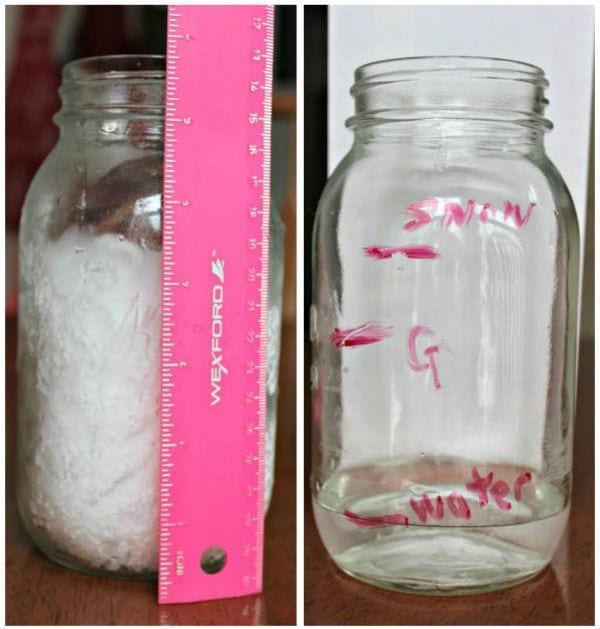
26. Measure the water content of snow
Difficulty: Easy / Materials: Basic
Two inches of snow is not the same as 2 inches of rain. This easy winter science experiment measures the amount of water actually found in an inch of snow.
Learn more: How Much Water Is in Snow?

27. Grow grass in an eggshell
Difficulty: Medium / Materials: Medium
What’s more fun than a preschool science experiment that doubles as a craft? You’ll need eggs, soil, grass seeds, water, and a permanent marker to bring this project to life. Kids will especially love personalizing their eggshell.
Learn more: Egg Grass Heads

28. Observe a pumpkin decomposing
Difficulty: Easy / Materials: Easy
When Halloween is over, plop your jack-o’-lantern pumpkin in the garden and observe it each day. Kids will learn how organic matter breaks down over time.
Learn more: Pumpkin Decomposition
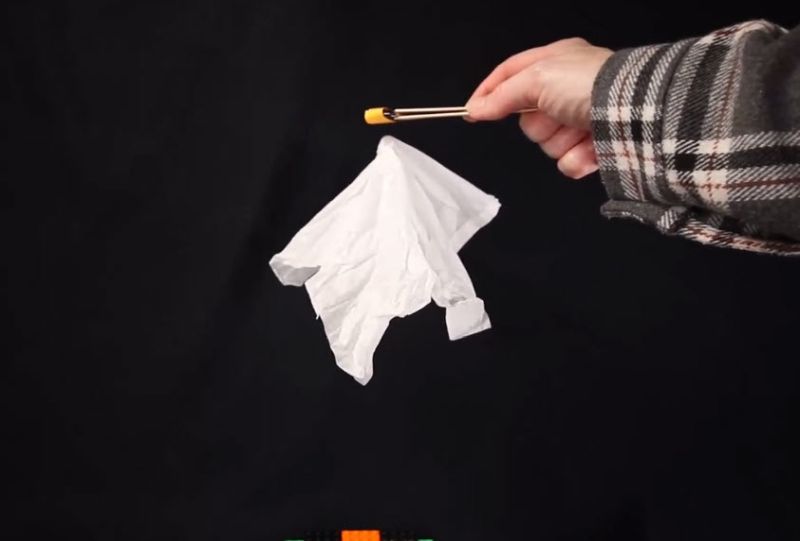
29. Send a ghost flying with magnets
Difficulty: Medium / Materials: Medium
Use magnets along with a few other supplies to make a tissue ghost seem to float in midair! It’s the perfect spooky Halloween science activity for preschoolers.
Learn more: Flying Ghosts

30. Conduct experiments using marshmallow Peeps
Difficulty: Easy / Materials: Medium
Pick up a package of marshmallow Peeps (they’re usually available during all seasons of the year now), and try turning them into little boats. Experiment with different sail sizes and types, and figure out how to make the candy boats go faster.
Learn more: Marshmallow Peep Boat Challenge
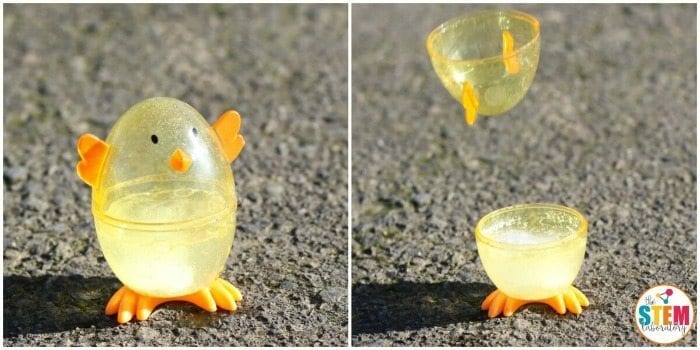
31. Launch plastic egg rockets
Difficulty: Easy / Materials: Medium
Put on some safety goggles and get ready for liftoff! This simple experiment uses Alka-Seltzer tablets to turn eggs into rockets.
Learn more: Easter Egg Rockets
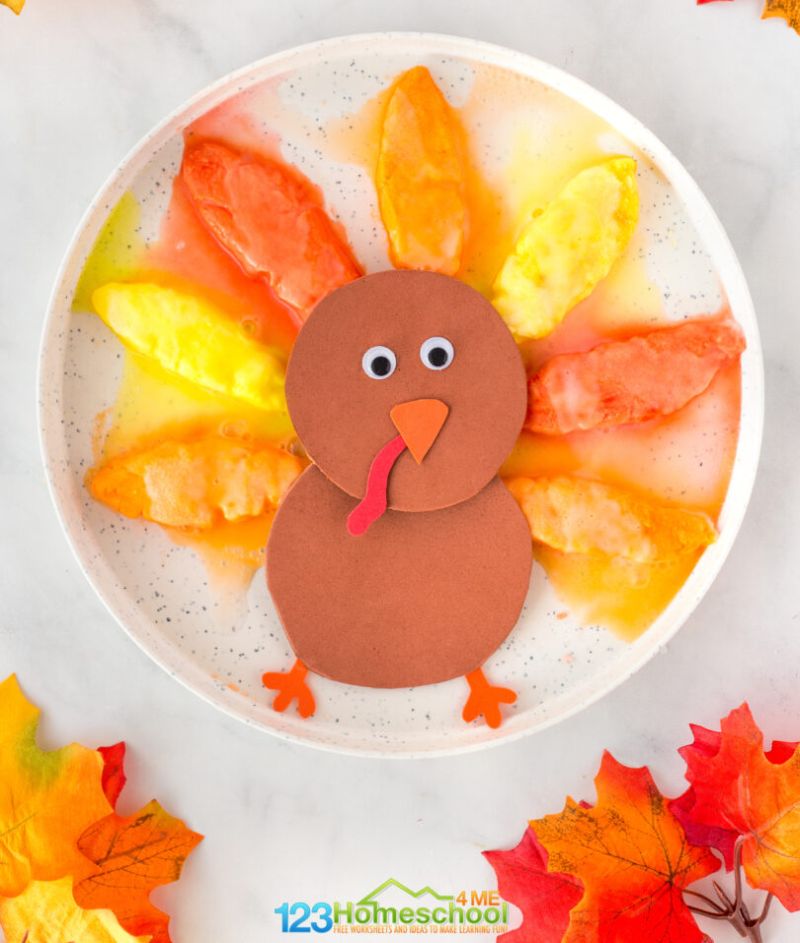
32. Dissolve colorful turkey “feathers”
Difficulty: Easy / Materials: Basic
Baking-soda-and-vinegar experiments are always popular, and this one is so cute for the Thanksgiving season. Build your own little turkey with baking soda feathers, then watch them foam up and dissolve when you add some vinegar.
Learn more: Turkey Feather Science
More Science Activities for Preschoolers
These science activities and experiments give preschoolers a chance to explore all sorts of science concepts, from plants and animals to germs and gravity and beyond.

33. Make a bouncy egg
Difficulty: Medium / Materials: Basic
Never underestimate the power of vinegar! See the striking result when you soak an egg in vinegar for hours.
Learn more: Bouncy Eggs
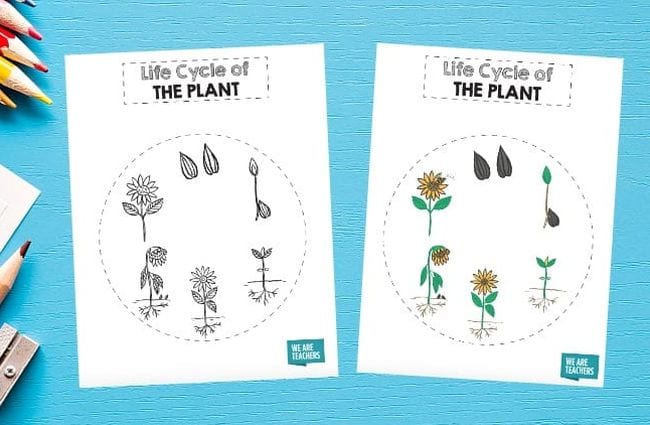
34. Learn about the plant life cycle in a hands-on way
Difficulty: Medium / Materials: Medium
Inspire a passion for gardening by planting seeds and watching them grow together. Download our free worksheets and classroom slides for an entire plant unit below.
Learn more: Plant Life Cycle Resources
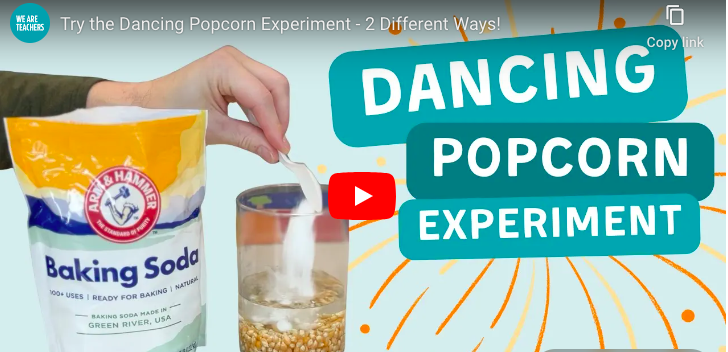
35. Boogie down with some popcorn
Difficulty: Medium / Materials: Medium
Try this super-fun experiment that gets popcorn dancing! Then, make a little popcorn in the microwave, put on some music, and have a dance party.
Learn more: Dancing Popcorn
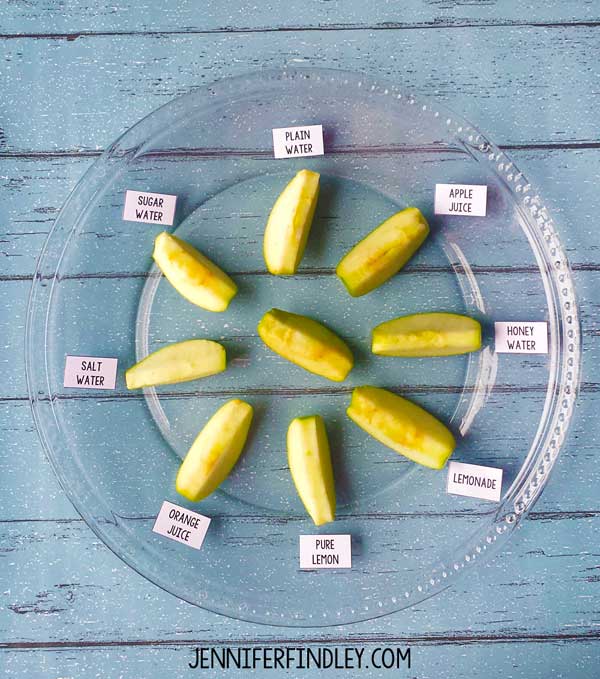
36. Slice apples to learn about oxidation
Difficulty: Easy / Materials: Basic
Here’s another classic preschool science activity: using apple slices to learn about oxidation (and how to prevent it). When you’re done, you’ve got a tasty snack to eat too.
Learn more: Apple Oxidation
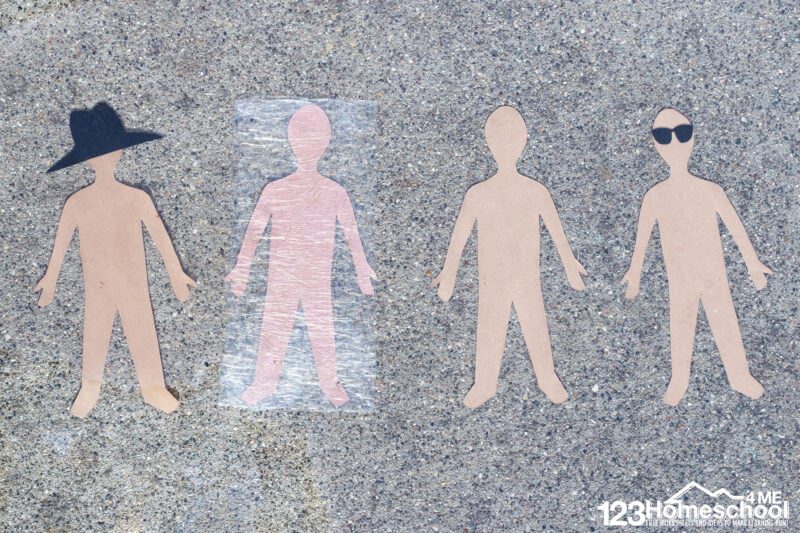
37. Show why sunscreen is important
Difficulty: Easy / Materials: Basic
First, have your students make four construction-paper people, each with varying conditions. Wrap one in plastic wrap, cover another in sunscreen, put a hat on one and a set of sunglasses on another. Ask kids to hypothesize what will happen when they’re left out in the sun, then see if they’re right!
Learn more: Sunscreen Experiment
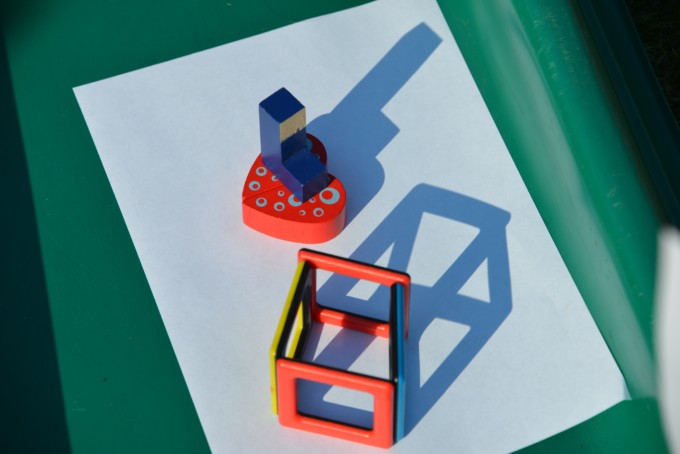
38. Engage in shadow science
Difficulty: Easy / Materials: Basic
Set blocks or small shaped objects on a sheet of paper. Then set the paper in direct sunlight. Watch as the shadow changes throughout the day. Have students trace the shadows with a pencil or marker.
Learn more: Shadow Science

39. Mix up some “magic” milk
Difficulty: Easy / Materials: Basic
A drop or two of dish soap will make food coloring dance and swirl across the surface of a shallow bowl of milk. Preschool science experiments often seem like magic, but this one is all about surface tension and chemical reactions.
Learn more: Magic Milk
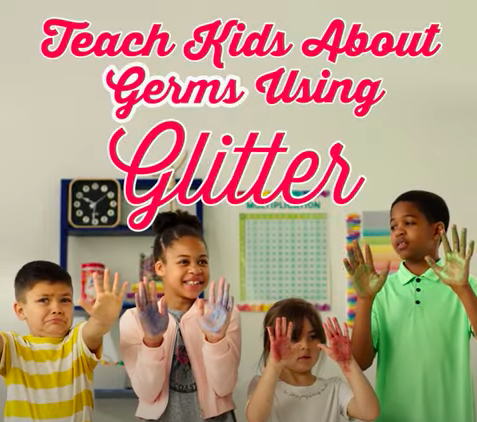
40. See how easily germs spread
Difficulty: Easy / Materials: Basic
We love science activities for preschoolers that remind them of the importance of good handwashing. Help them see why it’s so important with this simple experiment that uses glitter to stand in for germs.
Learn more: Teach Kids About Germs Using Glitter

41. Experiment with wax paper
Difficulty: Easy / Materials: Basic
This wax paper experiment is interesting from both a science and an art perspective. Ask kids to think about why wax paper behaves differently than other paper they use for art projects.
Learn more: Wax Paper Resist
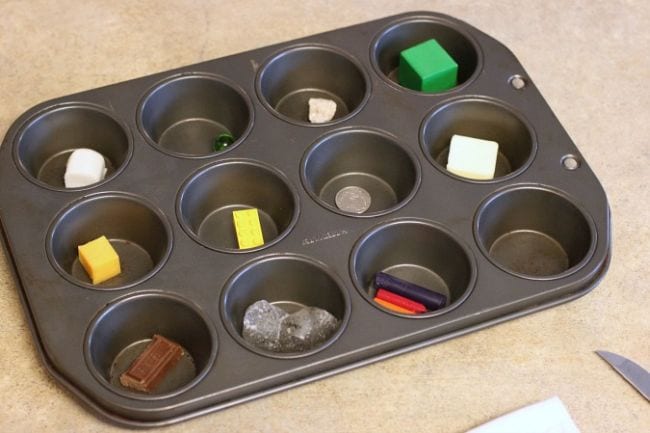
42. Predict and observe what will melt in the sun
Difficulty: Easy / Materials: Basic
You’ll need a hot sunny day for this preschool science experiment. Help students choose a variety of items to place into a muffin tin and have them predict which ones will melt. Set the tin out in the sun for an hour or two, then bring it in and record your results.
Learn more: Melting Science

43. Drop balls to introduce gravity
Difficulty: Easy / Materials: Basic
Gravity can be a complicated subject, but all pre-K kids need to understand the basics. Drop balls of all sizes to discover that they all fall in the exact same way.
Learn more: Ball Drop Gravity Race

44. Head to the playground to explore gravity and friction
Difficulty: Easy / Materials: Basic
What goes up must come down! A playground slide is the perfect place to help kids understand gravity. This is a good chance to learn about friction too.
Learn more: Playground Science
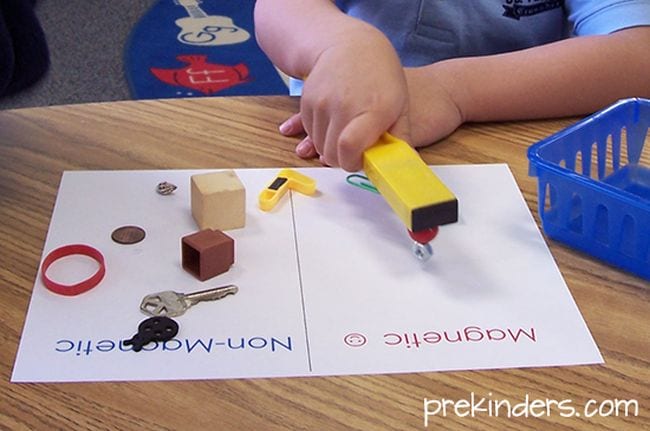
45. Test objects with magnets
Difficulty: Easy / Materials: Medium
Magnets are undeniably a source of fascination for kids. At this stage, you can worry less about explaining how magnets work and instead just let kids explore which items are attracted to magnets and which aren’t. Sort the items into categories, then see if the items have anything in common.
Learn more: Magnet Experiments

46. See sound waves in action
Difficulty: Easy / Materials: Medium
This series of simple experiments lets kids see sound waves at work. Start by making waves with a Slinky, then move on to tuning forks and bouncing confetti.
Learn more: Sound Experiment

47. Make an orange volcano
Difficulty: Easy / Materials: Basic
Making erupting volcanoes is a staple of any childhood! We love this easy volcano experiment using an orange, baking soda, and vinegar.
Learn more: Orange Volcano

48. Grow delicious rock candy crystals
Difficulty: Medium / Materials: Basic
Preschoolers love science activities that involve food. While crystal experiments are a hit with kids of any age, this one is perfect for the young crowd. It requires a little patience, but kids get to eat the yummy results!
Learn more: Kool-Aid Rock Candy
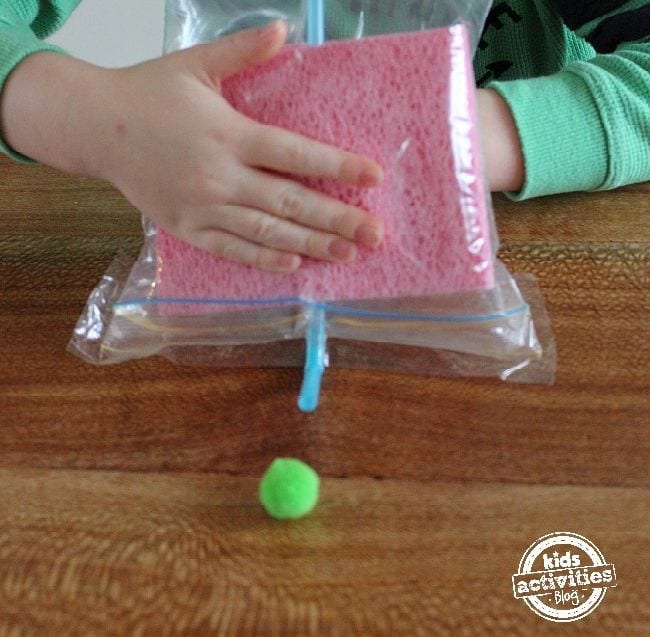
49. Move pom-poms with air pressure
Difficulty: Easy / Materials: Basic
Understanding the idea that air can have enough force to move objects can be a little challenging, but this simple experiment brings that concept to life. We love that this experiment is affordable since most people (especially teachers) already have these materials on hand.
Learn more: Air Pressure Experiment
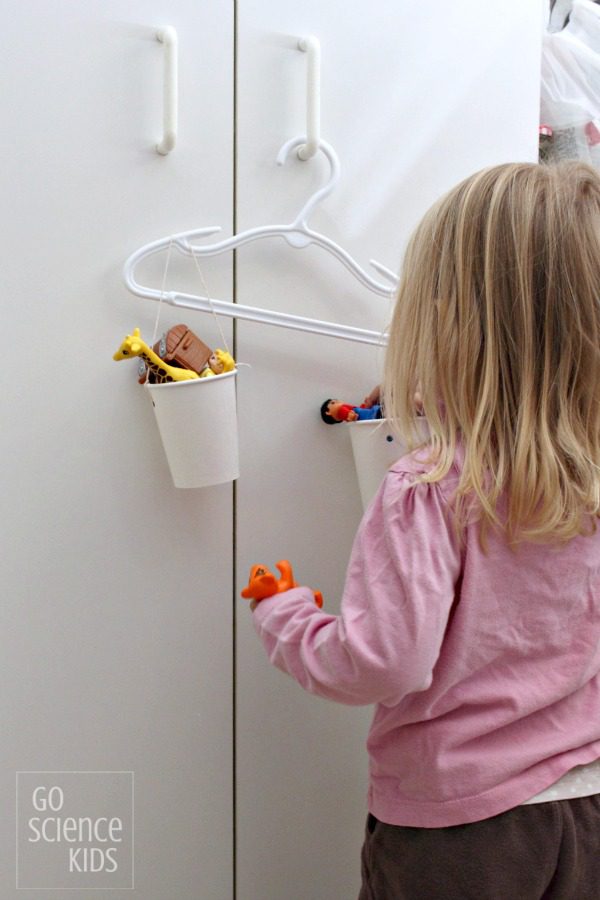
50. Make a balance scale
Difficulty: Easy / Materials: Basic
This simple balance scale is so easy to make yet provides endless opportunities for weighing all kinds of objects. Have kids assemble a scale from a plastic hanger, a few paper cups, and some string, then let them hypothesize which items will be heavier and which will be lighter.
Learn more: DIY Balance Scales

51. Explore the principle of static electricity
Difficulty: Easy / Materials: Basic
The concepts of negative and positive properties of atoms may be way over the heads of preschoolers, but this fun activity is perfect for introducing the magic of science to them.
Learn more: Static Electricity Activity
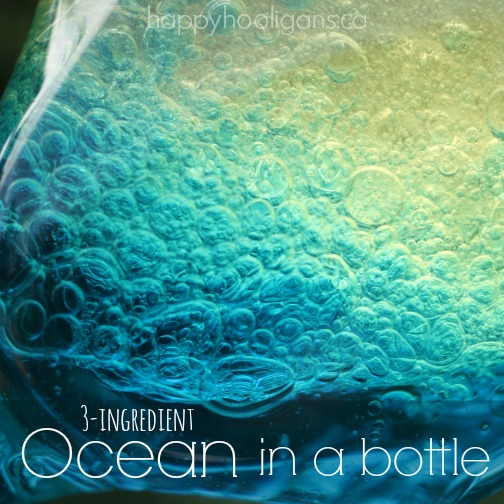
52. Make an ocean in a bottle
Difficulty: Medium / Materials: Basic
Oil, water, and food coloring combine to create a mesmerizing mini ocean in a bottle.
Learn more: Ocean in a Bottle
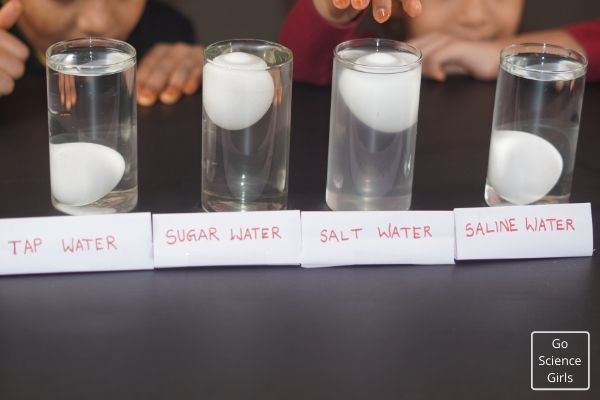
53. Explore the concept of density
Difficulty: Easy / Materials: Basic
Why do some objects float and some sink? Does it matter what type of liquid you put them in? Explore these questions and more with this simple activity.
Learn more: Egg Float

54. Make ice grow
Difficulty: Easy / Materials: Basic
Just like your favorite character from the movie Frozen, your preschoolers can have the power to make ice grow! This simple crystallization experiment will make a big impact on your little ones.
Learn more: Frozen Fun
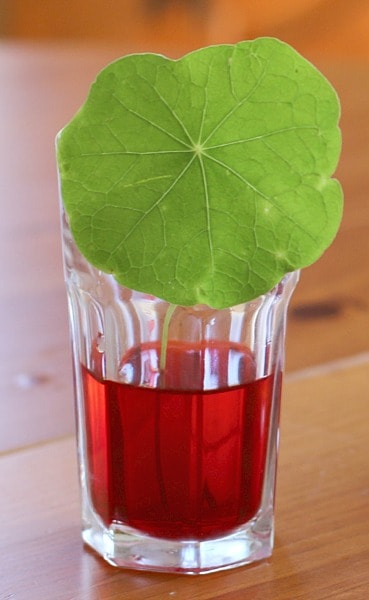
55. Watch leaves turn colors
Difficulty: Easy / Materials: Basic
Learn how a leaf gets nourishment through its network of veins, which act as a transportation route for nutrients from the stem to the tips of the leaf.
Learn more: Colored Leaves
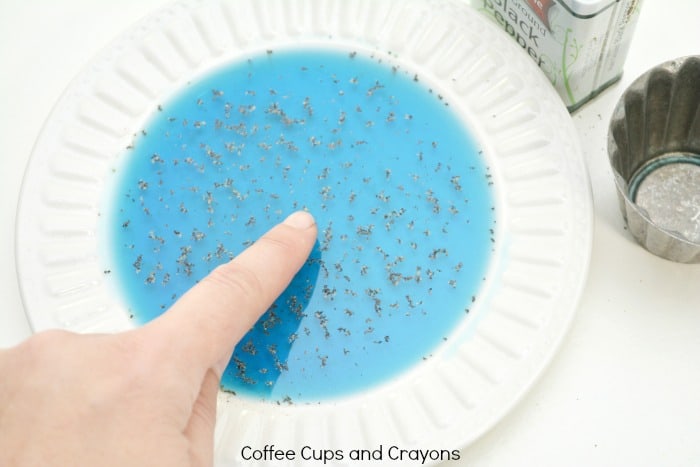
56. Make pepper dance
Difficulty: Easy / Materials: Basic
This science experiment is a perennial crowd favorite! Simply combine dish soap and water (and food color, if you wish) on a dish. Then cover the surface with a generous amount of pepper. Your preschoolers will giggle when the pepper scatters to the edges of the dish when they touch it with their finger.
Learn more: Dancing Pepper
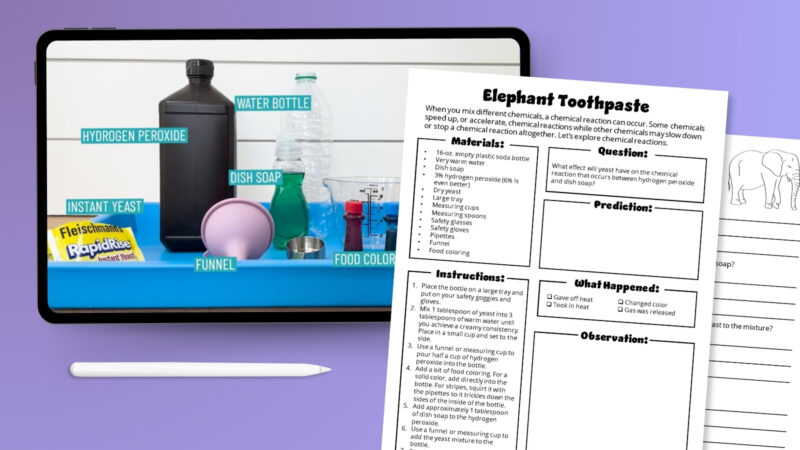
57. Cook up a batch of elephant toothpaste
Difficulty: Medium / Materials: Basic
Brace yourself for a crazy eruption of giant foam when you try this fun experiment with your preschool students. Psst: It’s all in the power of yeast.
Learn more: Elephant Toothpaste

58. Concoct a batch of invisible ink
Difficulty: Easy / Materials: Basic
Introduce your students to the secret power of invisible ink with this simple recipe. Easy to assemble, totally nontoxic, and loads of fun!
Learn more: Invisible Ink
Get my free printable

If you liked these science activities for preschoolers, grab a copy of our free printable recording sheet for your students, which can be used with any of the science experiments above.















